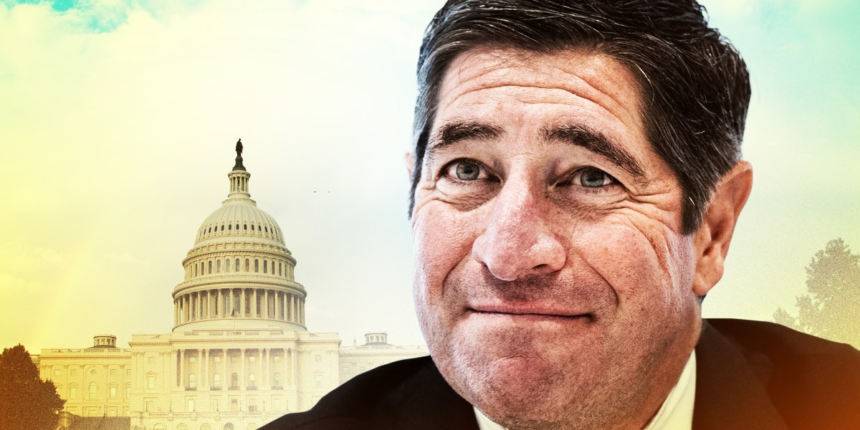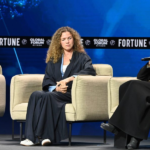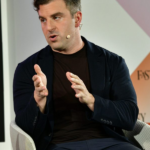Kupor sat through the briefing, then snapped a photo of Son—whom he had never met before—as Son posed in front of the lectern. In an interview with Fortune in August, Kupor laughed as he recounted it: “I’m a short guy. He was even shorter than I,” says Kupor, who says he is 5’5” tall “on a good day” when he isn’t sporting his cowboy boots for an extra inch of height. Later, Kupor was ushered into a ballroom where his interview was repeatedly pushed back for five hours, apparently so the President-Elect could work on a TikTok deal as the impending ban that same day approached.
“It was a lot of sitting around in an empty ballroom in Mar-a-Lago on my phone, trying to keep myself occupied,” Kupor recounts. “It was well worth waiting for, for sure.”
Kupor was officially sworn-in as director of the Office of Personnel Management (OPM) in July, where the venture capital operator is now overseeing the independent agency of the U.S. government that handles human resources policy, personnel oversight, and administration of key employee benefits, among other things. While not historically a very exciting or newsworthy White House agency, the OPM has, under President Trump, been at the forefront of one of the largest-scale federal labor cost-cutting efforts in modern U.S. history.
“DOGE—as a coalesced, centralized organization—at least from my perspective, it doesn’t exist in that form anymore,” Kupor said.
Still, the cost-cutting efforts are far from over and “efficiency” across the federal government continues to be a Trump Administration priority—and one that Kupor is now instrumental in seeing through. OPM, Kupor says, is part of the “implementation” or “institutionalization” of the efforts that Musk’s org had started. While the approach Kupor plans to take will likely look rather different than the first six months of Trump’s Administration—putting a kinder, gentler, and less controversial face to the job—Americans can still expect that the cuts will be sweeping.
Kupor clearly believes the former. “You have to find ways to rebuild trust, and the way you rebuild trust, in my mind, is, number one: You actually treat with respect the people who are walking out the door,” Kupor told Fortune.
In one early sign of course correcting, Kupor says that many of the federal agencies that OPM’s 250-person consulting team works with are taking a fresh look at their staffing plans to account for greater-than-expected attrition from deferred resignations. “A lot of people are going through and revisiting,” he said.
Within OPM itself, Kupor says his team is evaluating whether there were areas that “we cut too deep” during the layoffs or whether there were special skills that people had that were lost. Approximately 1,000 people—or 33% of its workforce—will no longer be with OPM by the end of the year, he said.
Still, in a display of the diplomacy necessary for navigating Silicon Valley’s fraught terrain of founders, frenemies, and big egos, Kupor wouldn’t comment on Musk or DOGE’s approach before he arrived at OPM. “I don’t know all the ins and outs of decisions that were made on how they did stuff in those first several months when I wasn’t here. And so, look, I just think it’s not constructive for me to try to Monday morning quarterback that,” he said.
“He was our very first hire at a16z, because he is the best executive that we’ve worked with. He’s super smart, detail-oriented, great culturally, and the hardest working man in the business,” Horowitz told Fortune in an email, noting that Kupor’s leadership will translate “extremely well” into government and that “his tireless energy will enable him to crack through the bureaucracy and enable people to do their best work.”
After being sworn in as OPM Director this summer, Kupor became one of several prominent Silicon Valley investors and entrepreneurs to join the Trump administration, alongside Craft Ventures’ David Sacks, who is the AI and Crypto Czar; Senior White House AI policy advisor Sriram Krishnan, who also previously worked at a16z; and Gregory Barbaccia, a former Palantir employee who is now Federal Chief Information Officer at the Office of Management and Budget.
For Kupor, he makes it out as a natural fit. He was a public policy major at Stanford University, where he worked on behalf of the Japanese government at a policy institute during undergrad and law school and later worked as an intern for a health care policy advisor during the George H. W. Bush Administration, the late Gail Wilensky. For a time, Kupor served as chair of the National Venture Capital Association, a trade association that lobbies Washington for the interests of private market investors, and he also did crypto and capital markets-related policy work at a16z.
“I always thought I wanted to do something at some point in government service. Life got in the way,” Kupor said later, noting that “everything sort of came together to make this role a reality.”
A16z might have much to gain by having a former top partner in the White House. Horowitz and Andreessen said in a widely-viewed video last year that the Biden Administration had not been accessible. Kupor’s seat in the Cabinet surely helps with some of that access, or may put some of their portfolio companies in better positions to win government contracts.
When I followed up with Kupor about conflicts of interest, he said he doesn’t see any, as he is not in a policy position that has influence over the matters a16z is interested in, and that he “specifically wanted to take a role that was focused on very different things.”
“I don’t see any conflict in what I am doing,” he said. “As an American, I believe that tech and entrepreneurship are key to our ongoing economic strength, national security and sovereignty… My role at OPM is simply to ensure that the government can attract and retain the very best people to work efficiently on behalf of the American taxpayer.”
When asked for comment, an a16z spokeswoman said there were no conflicts of interest.
Since being named as director, Kupor has been focused on performance management and hiring—two areas he cites as priorities of President Trump that came up during his initial interview—as well as trying to find areas where technology could make federal workers more efficient.
Some of the changes Kupor hopes to make are more cultural, he says. He wants to see federal workers experimenting with different technologies and tools. For example, Kupor said he hopes to roll out an AI tool to help rulemaking committees parse through public comments for new rule proposals and respond to them.
“We have teams of people who are literally manually reading all those things, drafting responses. I saw one response that was literally 80 pages long to one comment. It doesn’t take that much imagination to imagine: There’s probably ways where AI can increase the efficiency.”
Kupor’s approach to the role is undeniably influenced by his background in tech—espeically in the way he talks about the federal government’s approach to risk.
“There’s just such a culture here of such risk aversion, and I understand why it is, but we got to just fight against that,” Kupor said. He added: “It’s a cultural change as much as it is a learning and a technological change. And look, I’m highly confident we’ll get there, but it does require kind of a reset on people’s willingness to take some level of risk.”
But Kupor also emphasizes in our conversation that he understands government is not the private sector.
“This is not venture capital—so we’re not going to shoot-for-the-moon risk. But we can afford to take some risk on things…Where maybe the payoff is we get a five or ten percent increase in efficiency. That would be awesome. I’d take that any day.”









